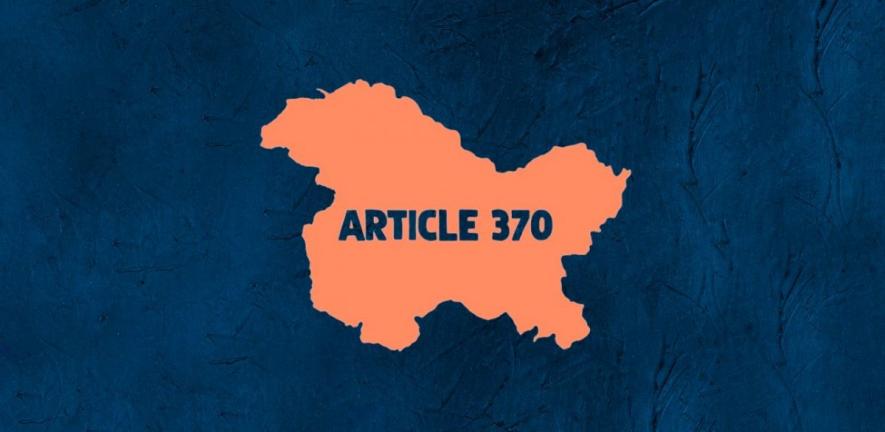Revocation of Article 370 in Kashmir Through the Lawfare Lens

The underlying message of the revocation of Article 370 was that the mandate received by the BJP in the 2019 general elections in India negates the need for any participatory resolution of the political question of Kashmir.
—
Law can be an instrument for good. It can also be a tool to undertake ‘warfare’ or ‘lawfare’, including by a government against its ‘own’ citizens in a democracy because democracy is not always about consent, it is as much about coercion.
Kashmir stands as a starkly poignant example of a coercive democracy brought about by lawfare.
It is difficult to locate the particular period when the term ‘lawfare’ emerged, but as a concept, it manifested in colonial legal experiments. Anthropologists and legal scholars speak about the experiences of colonised people when they encountered colonial law, foreign and alien, which was nevertheless imposed on them.
The obscure language, intimidating procedures, structures of courts, paraphernalia and the organised coercion to abide by law in the name of a ‘civilising mission’ was how law became an instrument to subjugate. This may have been ‘welfare’ for those deploying law but it was ‘lawfare’ for those subjected to its impersonal rigour and violent force.
In contemporary times, lawfare has found usage as a military tactic, to use legal measures such as economic sanctions against another party in a conflict, with or without accompanying military operations.
Kashmir stands as a starkly poignant example of a coercive democracy brought about by lawfare.
What remains common in both these conceptions of ‘lawfare’ is the instrumentalisation of law by one party, generally the more powerful party which can use force to extract compliance with the law, against another party.
Lawfare can be deployed outrightly as a means to defeat in a war. It can also be covertly deployed to disempower by disguising it as a measure that will bring about the good of the party subjected to the law. In doing so, it becomes a tool to conquer and control.
In this article, I will argue that the gradual erosion and the eventual nullification of Article 370 indicate the use of lawfare by the government of India in Kashmir to forcibly complete the so-called integration project.
The judgment of the Supreme Court unreservedly upholding the legal manoeuverings of the government of India further sharpens the impact of disempowerment through lawfare.
Lawfare through exploitation of Article 370
Article 370, as a legal provision not only had a unique purpose, but it was ironically, uniquely designed to defeat the very same purpose. As the following discussion will show, this unique design enabled the legal manipulations which ultimately resulted in the nullification of Article 370 itself, while a political resolution was completely abandoned.
The purpose of Article 370, as noted by legal scholar A.G. Noorani in his book on the constitutional history of the Article, was to be a “solemn compact” between the government of India and the then State of Jammu and Kashmir, being the “only State in the Union of India which negotiated the terms of its membership with the Union”.
Through this negotiation, Jammu and Kashmir joined the Union of India but also retained some autonomy. The way Article 370 was designed, however, enabled the President of India to extend various provisions of the Indian Constitution to the State of Jammu and Kashmir through Executive Orders.
But this power was not unilateral. According to Noorani, who based his argument on a historical analysis of the drafting of Article 370, this power was only interim in nature. It could not be exercised once the Constituent Assembly of Jammu and Kashmir was dissolved, as it was “the sole ratificatory authority” over the exercise of this power.
However, this is not how successive governments interpreted Article 370. Through a series of Executive Orders issued over decades, several provisions of the Indian Constitution were extended to the State of Jammu and Kashmir, and the Constitution of Jammu and Kashmir was also “overridden”, according to Noorani.
This is what makes the history of gradual ‘erosion’ of Article 370 an exercise of ‘lawfare’ as it amounts to the exploitation of a legal instrument to achieve the opposite of the purpose for which the instrument was intended, thus inflicting violence on its original intent.
Article 370 was a legal settlement between two conflicting political notions of integration and autonomy. Public opinion may be divided on which is a better political ideal to aspire for, but Article 370 eventually became an instrument to chip away at the autonomy of the people of Kashmir for greater integration with India.
Its impact?
Noorani notes in his book a remark made by a member of the Parliamentary Delegation which visited Kashmir and interacted with people in 2010, “The intensity of alienation surprised me”!
Article 370, as a legal provision not only had a unique purpose, but it was ironically, uniquely designed to defeat the very same purpose.
To counter this, Noorani recommended a new “Constitutional settlement” to amend Article 370 to prevent further “abuse” by removing the President’s power to make Executive Orders under this Article, as it could even include an Order to make Article 370 itself inoperative.
What was forewarned, eventually came to pass in 2019.
The legally violent overhauling of the Article 370 regime in J&K
As I recount how the eventual nullification of Article 370 played out, notice how a legal solution replaced a political resolution at each step.
In 2018, the Bharatiya Janata Party (BJP) withdrew support from the Jammu and Kashmir People’s Democratic Party (PDP)–BJP coalition government leading to the resignation of Mehbooba Mufti as the chief minister and the imposition of governor’s rule in J&K.
A few months later, as per media reports, despite attempts by some political parties to form a government, the governor dissolved the legislative assembly and recommended the imposition of President’s rule. This step of dissolving the assembly is extremely crucial and paves the way for all further legal manipulations that happen. It marked the beginning of a lawfare.
President’s rule under Article 356 of the Constitution was imposed in J&K in December 2018 and extended in June 2019. J&K is no stranger to President’s rule, through which the government of India takes over the governance of a state. As per reports, President’s rule has been imposed on J&K eight times since 1977 alone!
During President’s rule, the Parliament gets all the powers to act as the J&K state assembly. Since no elected government has been in place in J&K since 2018, the Parliament continues to speak for it till today. All Bills and budgets related to J&K continue to be passed by the Indian Parliament. Additionally, the President takes over and speaks for the government of the state through the governor.
This step of dissolving the assembly is extremely crucial and paves the way for all further legal manipulations that happen.
Now, there are two things to note here. First, these are emergency powers that have been made routine in Kashmir. This paints an image of a strong state always in conflict with the people, trying to control them through the legal instrument of President’s rule. This amounts to strategic use of law to gain advantage in a conflict, or lawfare.
Second, President’s rule is meant as a temporary arrangement till an elected government can manage the affairs of the state in a constitutional manner.
Using a temporary power to make permanent changes in the constitutional relationship between India and J&K, providing no opportunity to people of J&K to even have a say in the process, amounts to lawfare.
(This lawfare tactic unfortunately received a stamp of approval from the Supreme Court in its judgment, which, as has been argued, sets dangerous precedents.)
Then on August 5, 2019, after an intense buildup of troops in J&K and under a near total communication blockade and curfew, as if it indeed was a ‘warfare’ scenario, the final and the most elaborately orchestrated ‘lawfare’ takes place.
First, a Constitutional Order (CO 272) was issued by the President under Article 370 to say that all provisions of the Indian Constitution will now apply to J&K. With no state government in existence to consult or concur with, the President, acting as the state government under President’s rule, basically consulted himself to issue this CO.
Through this CO, the government also amended, without actually amending the Constitution, Article 367, an interpretation clause, to slyly replace “Constituent Assembly” as used in Article 370 with the “Legislative Assembly of the State”.
This sleight of hand was held to be unconstitutional by the Supreme Court in its judgment, however, to no consequence.
The effect of this— Article 370 provides that if the President of India wishes to issue a public notification to declare that Article 370 itself will cease to operate, it can only do so on the recommendation of the “Constituent Assembly” of the State of J&K.
The petitioners, much like Noorani, had argued before the Supreme Court that the Constituent Assembly had dissolved without recommending nullification of Article 370, which made the Article a permanent feature of the constitutional relationship between India and J&K.
However, by replacing the phrase “Constituent Assembly” with “Legislative Assembly of the State”, CO 272 made legally possible something that seemed politically very difficult, if not entirely impossible.
The government also amended, without actually amending the Constitution, Article 367, an interpretation clause, to slyly replace “Constituent Assembly” as used in Article 370 with the “Legislative Assembly of the State”.
Now, to issue the notification nullifying Article 370, the President only needed a recommendation from the state assembly, which at that time, for all intents and purposes, was the Indian Parliament.
So, after CO 272 was issued, as soon as the Parliament convened on August 5, 2019, Union home minister Amit Shah moved a ‘surprise’ resolution before Rajya Sabha to recommend to the President to make Article 370 inoperative.
Surprise because there was no prior notice provided to members of the Parliament for the same. It was adopted, despite intense opposition. On August 6, 2019, a similar resolution was moved before Lok Sabha and again, despite vociferous opposition, it was adopted.
On the same day, the President issued CO 273 and nullified Article 370. All it took was a series of complex legal manipulations, which also explains why Solicitor General Tushar Mehta was a close confidant of the government through the process, even as many political actors were kept in the dark.
These legal manipulations were violent because of the non-participatory and coercive manner in which the change in legal regime was brought about, and hence amount to lawfare.
The reorganisation of the state into two Union territories in violation of many rules and conventions was another manifestation of exerting control through law or lawfare.
The underlying message was that the mandate received by the BJP in the 2019 general elections in India negates the need for any participatory resolution of the political question of integration of Kashmir.
The Supreme Court of India, in its judgment, also upheld this political project of the BJP executed through lawfare by stating that the President (acting on the advice of government of India) could unilaterally abrogate Article 370 even as the Article itself explicitly requires a recommendation from the Constituent Assembly for this purpose.
It has been argued that this requirement of prior recommendation from the Constituent Assembly was an acknowledgment of the need to keep the ‘participation and consent of people’ of J&K at the heart. Lawfare tactics, however, disregard participation, as the state is capable of extracting ‘consent’ to any law it makes, resistance to which can come at great cost to the life and liberty of people.
State speaks through the law, but for whom?
The command of the State is the law. The State has a monopoly over the legitimate use of violence to extract compliance with its law. This is what makes ‘law’ a potent tool for conducting warfare— it is calculated, mechanical, impersonal and impervious to the violence it may inflict on those subjected to it, and its compliance can be ensured by the State through the use of force.
The violence of a lawfare tactic may not always be physically evident or people may be prevented from even comprehending the violence, but absence of evidence is not evidence of absence.
The Constituent Assembly had dissolved without recommending nullification of Article 370, which made the Article a permanent feature of the constitutional relationship between India and J&K.
For instance, through the use of yet other legal instruments to impose internet shutdowns and curfews, the entire State of J&K was shrouded in forced silence, even as the Indian Parliament, the government of India and the President of India claimed to speak for the people of J&K.
The process of political negotiations was completely sidelined and the role of politics was only limited to packaging and selling a lawfare solution as a benevolent gesture of the Indian State.
The State claimed to speak for the people who themselves did not know what was in their best interest. Similar to the colonial usage of law as a tool to subjugate in the name of ‘civilising mission’, the government of India justified these lawfare tactics by arguing that Article 370 had kept the people of J&K in a perpetual state of under-development and conflict.
The Supreme Court judgment has now provided a cloak of legitimacy to these legal maneouverings, ostensibly with the objective of bringing to a certain legal end the political uncertainties regarding Kashmir’s integration with India.
The State claimed to speak for the people who themselves did not know what was in their best interest.
Indeed, within Kashmir itself, some may subscribe to this view and would have made peace. After all, lawfare is a one-sided war. On one hand, is the State with its laws and apparatus to demand compliance and on the other hand, citizens, who may sometimes resort to protests against lawfare tactics, but the power dynamics always remain extremely lopsided.
The temptation to celebrate these legal manipulations as masterstroke may be strong, but the disempowerment of people and the violence of these lawfare tactics will continue to loom large.
Maansi Verma is a lawyer interested in constitutional questions.
Get the latest reports & analysis with people's perspective on Protests, movements & deep analytical videos, discussions of the current affairs in your Telegram app. Subscribe to NewsClick's Telegram channel & get Real-Time updates on stories, as they get published on our website.























